Herbie Bradley
Why Has Predicting Downstream Capabilities of Frontier AI Models with Scale Remained Elusive?
Jun 06, 2024



Abstract:Predictable behavior from scaling advanced AI systems is an extremely desirable property. Although a well-established literature exists on how pretraining performance scales, the literature on how particular downstream capabilities scale is significantly muddier. In this work, we take a step back and ask: why has predicting specific downstream capabilities with scale remained elusive? While many factors are certainly responsible, we identify a new factor that makes modeling scaling behavior on widely used multiple-choice question-answering benchmarks challenging. Using five model families and twelve well-established multiple-choice benchmarks, we show that downstream performance is computed from negative log likelihoods via a sequence of transformations that progressively degrade the statistical relationship between performance and scale. We then reveal the mechanism causing this degradation: downstream metrics require comparing the correct choice against a small number of specific incorrect choices, meaning accurately predicting downstream capabilities requires predicting not just how probability mass concentrates on the correct choice with scale, but also how probability mass fluctuates on specific incorrect choices with scale. We empirically study how probability mass on the correct choice co-varies with probability mass on incorrect choices with increasing compute, suggesting that scaling laws for incorrect choices might be achievable. Our work also explains why pretraining scaling laws are commonly regarded as more predictable than downstream capabilities and contributes towards establishing scaling-predictable evaluations of frontier AI models.
Visibility into AI Agents
Feb 04, 2024

Abstract:Increased delegation of commercial, scientific, governmental, and personal activities to AI agents -- systems capable of pursuing complex goals with limited supervision -- may exacerbate existing societal risks and introduce new risks. Understanding and mitigating these risks involves critically evaluating existing governance structures, revising and adapting these structures where needed, and ensuring accountability of key stakeholders. Information about where, why, how, and by whom certain AI agents are used, which we refer to as visibility, is critical to these objectives. In this paper, we assess three categories of measures to increase visibility into AI agents: agent identifiers, real-time monitoring, and activity logging. For each, we outline potential implementations that vary in intrusiveness and informativeness. We analyze how the measures apply across a spectrum of centralized through decentralized deployment contexts, accounting for various actors in the supply chain including hardware and software service providers. Finally, we discuss the implications of our measures for privacy and concentration of power. Further work into understanding the measures and mitigating their negative impacts can help to build a foundation for the governance of AI agents.
Hazards from Increasingly Accessible Fine-Tuning of Downloadable Foundation Models
Dec 22, 2023Abstract:Public release of the weights of pretrained foundation models, otherwise known as downloadable access \citep{solaiman_gradient_2023}, enables fine-tuning without the prohibitive expense of pretraining. Our work argues that increasingly accessible fine-tuning of downloadable models may increase hazards. First, we highlight research to improve the accessibility of fine-tuning. We split our discussion into research that A) reduces the computational cost of fine-tuning and B) improves the ability to share that cost across more actors. Second, we argue that increasingly accessible fine-tuning methods may increase hazard through facilitating malicious use and making oversight of models with potentially dangerous capabilities more difficult. Third, we discuss potential mitigatory measures, as well as benefits of more accessible fine-tuning. Given substantial remaining uncertainty about hazards, we conclude by emphasizing the urgent need for the development of mitigations.
Neural MMO 2.0: A Massively Multi-task Addition to Massively Multi-agent Learning
Nov 07, 2023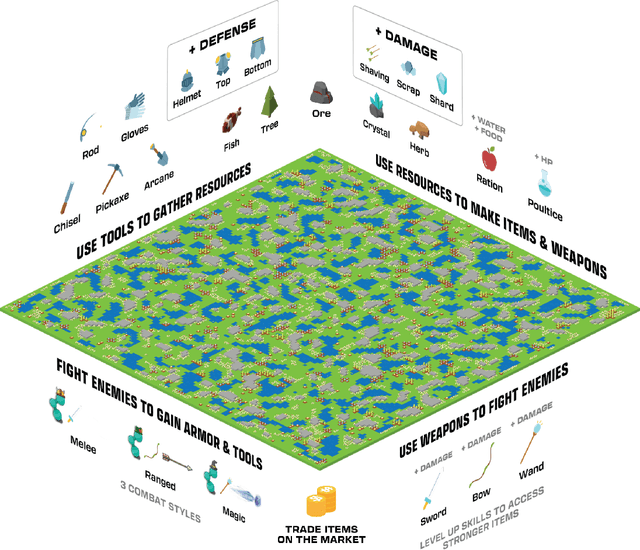
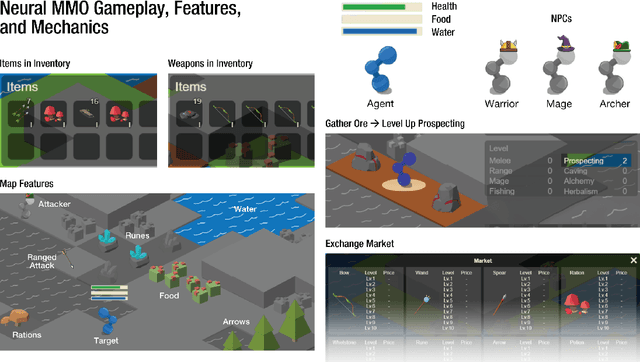
Abstract:Neural MMO 2.0 is a massively multi-agent environment for reinforcement learning research. The key feature of this new version is a flexible task system that allows users to define a broad range of objectives and reward signals. We challenge researchers to train agents capable of generalizing to tasks, maps, and opponents never seen during training. Neural MMO features procedurally generated maps with 128 agents in the standard setting and support for up to. Version 2.0 is a complete rewrite of its predecessor with three-fold improved performance and compatibility with CleanRL. We release the platform as free and open-source software with comprehensive documentation available at neuralmmo.github.io and an active community Discord. To spark initial research on this new platform, we are concurrently running a competition at NeurIPS 2023.
Quality-Diversity through AI Feedback
Oct 31, 2023



Abstract:In many text-generation problems, users may prefer not only a single response, but a diverse range of high-quality outputs from which to choose. Quality-diversity (QD) search algorithms aim at such outcomes, by continually improving and diversifying a population of candidates. However, the applicability of QD to qualitative domains, like creative writing, has been limited by the difficulty of algorithmically specifying measures of quality and diversity. Interestingly, recent developments in language models (LMs) have enabled guiding search through AI feedback, wherein LMs are prompted in natural language to evaluate qualitative aspects of text. Leveraging this development, we introduce Quality-Diversity through AI Feedback (QDAIF), wherein an evolutionary algorithm applies LMs to both generate variation and evaluate the quality and diversity of candidate text. When assessed on creative writing domains, QDAIF covers more of a specified search space with high-quality samples than do non-QD controls. Further, human evaluation of QDAIF-generated creative texts validates reasonable agreement between AI and human evaluation. Our results thus highlight the potential of AI feedback to guide open-ended search for creative and original solutions, providing a recipe that seemingly generalizes to many domains and modalities. In this way, QDAIF is a step towards AI systems that can independently search, diversify, evaluate, and improve, which are among the core skills underlying human society's capacity for innovation.
Challenges and Applications of Large Language Models
Jul 19, 2023Abstract:Large Language Models (LLMs) went from non-existent to ubiquitous in the machine learning discourse within a few years. Due to the fast pace of the field, it is difficult to identify the remaining challenges and already fruitful application areas. In this paper, we aim to establish a systematic set of open problems and application successes so that ML researchers can comprehend the field's current state more quickly and become productive.
Pythia: A Suite for Analyzing Large Language Models Across Training and Scaling
Apr 03, 2023
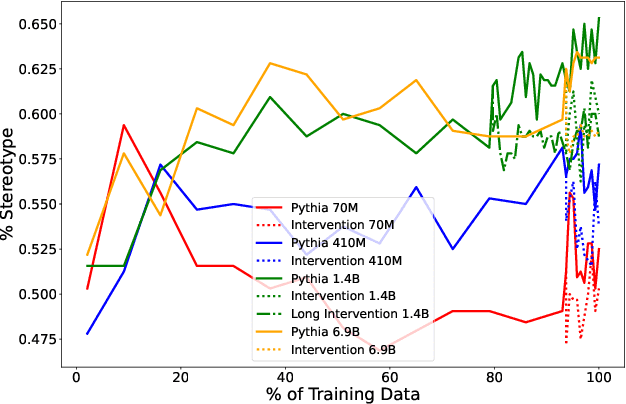
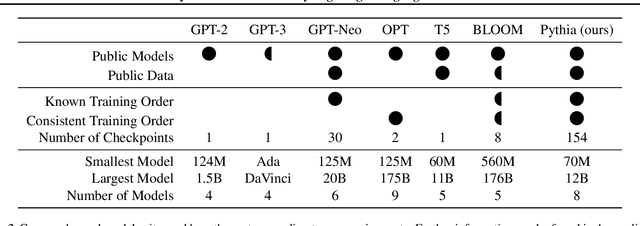
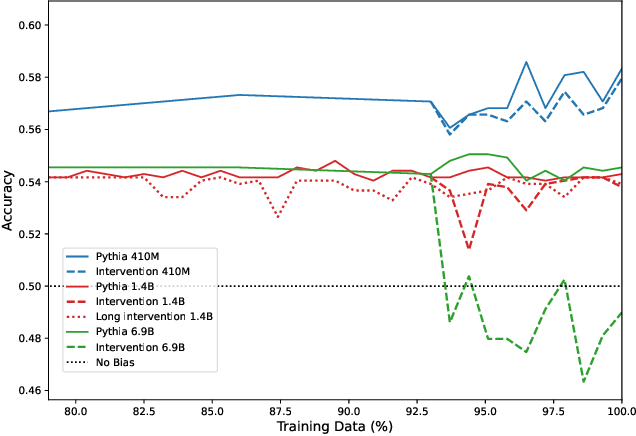
Abstract:How do large language models (LLMs) develop and evolve over the course of training? How do these patterns change as models scale? To answer these questions, we introduce \textit{Pythia}, a suite of 16 LLMs all trained on public data seen in the exact same order and ranging in size from 70M to 12B parameters. We provide public access to 154 checkpoints for each one of the 16 models, alongside tools to download and reconstruct their exact training dataloaders for further study. We intend \textit{Pythia} to facilitate research in many areas, and we present several case studies including novel results in memorization, term frequency effects on few-shot performance, and reducing gender bias. We demonstrate that this highly controlled setup can be used to yield novel insights toward LLMs and their training dynamics. Trained models, analysis code, training code, and training data can be found at https://github.com/EleutherAI/pythia.
Language Model Crossover: Variation through Few-Shot Prompting
Feb 23, 2023Abstract:This paper pursues the insight that language models naturally enable an intelligent variation operator similar in spirit to evolutionary crossover. In particular, language models of sufficient scale demonstrate in-context learning, i.e. they can learn from associations between a small number of input patterns to generate outputs incorporating such associations (also called few-shot prompting). This ability can be leveraged to form a simple but powerful variation operator, i.e. to prompt a language model with a few text-based genotypes (such as code, plain-text sentences, or equations), and to parse its corresponding output as those genotypes' offspring. The promise of such language model crossover (which is simple to implement and can leverage many different open-source language models) is that it enables a simple mechanism to evolve semantically-rich text representations (with few domain-specific tweaks), and naturally benefits from current progress in language models. Experiments in this paper highlight the versatility of language-model crossover, through evolving binary bit-strings, sentences, equations, text-to-image prompts, and Python code. The conclusion is that language model crossover is a promising method for evolving genomes representable as text.
EleutherAI: Going Beyond "Open Science" to "Science in the Open"
Oct 12, 2022Abstract:Over the past two years, EleutherAI has established itself as a radically novel initiative aimed at both promoting open-source research and conducting research in a transparent, openly accessible and collaborative manner. EleutherAI's approach to research goes beyond transparency: by doing research entirely in public, anyone in the world can observe and contribute at every stage. Our work has been received positively and has resulted in several high-impact projects in Natural Language Processing and other fields. In this paper, we describe our experience doing public-facing machine learning research, the benefits we believe this approach brings, and the pitfalls we have encountered.
 Add to Chrome
Add to Chrome Add to Firefox
Add to Firefox Add to Edge
Add to Edge